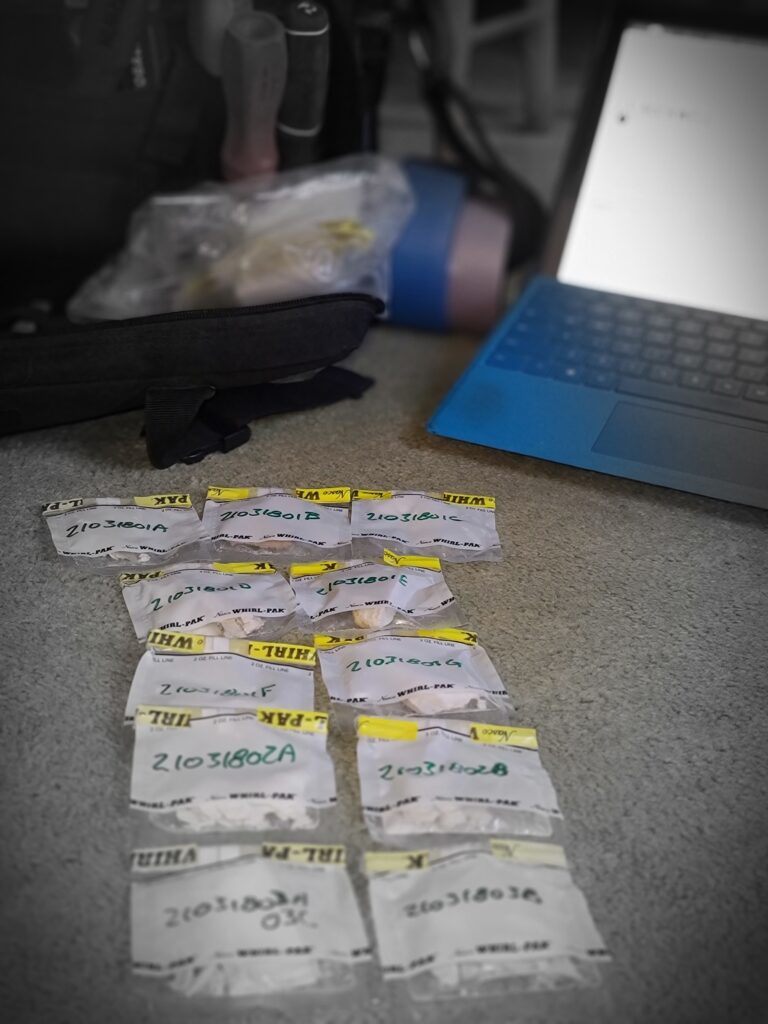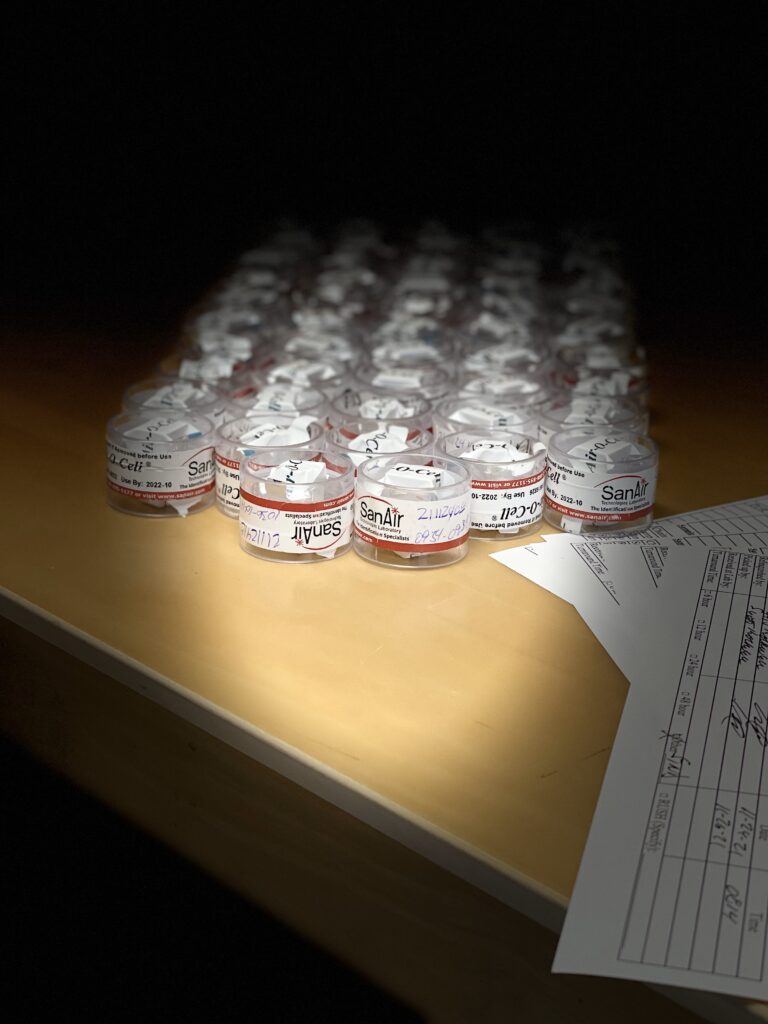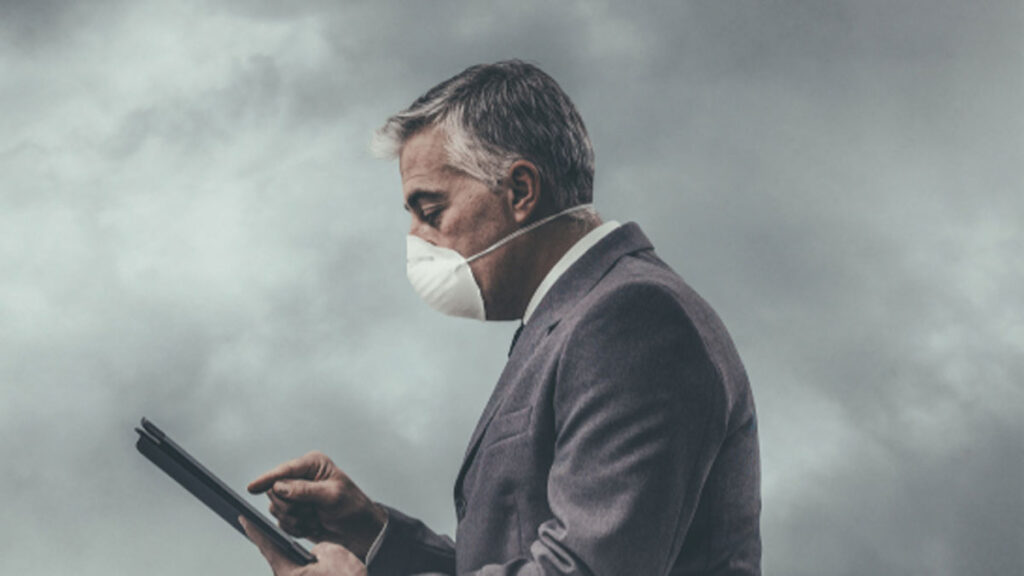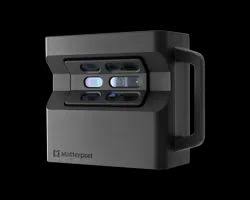Property damage and incidental contamination never occurs at a convenient time; we work on your schedule. With your home, place of work, or place of play in disarray from water, fire/smoke/soot, mold, or any other type of environmental contamination we will respond quickly – same day in most cases – to assess the damage, initialize containment, isolation, and stabilization, and recommend retention of a mitigation team best suited to the needs of your project. We will work side by side with your insurance carrier, property representative, and mitigation or remediation professional to develop a work plan that will limit secondary or peripheral damage, address existing damage and contamination, identify cause & origin, and prevent recurrence. We will build a work protocol designed specifically for your project with comprehensive field & laboratory analysis, detailed reporting, and mitigation recommendations that best fit your needs.

Asbestos CONTAINING MATERIALS
Survey & Inspection
The term “Asbestos” defines a group of six naturally occurring fibrous minerals found in certain types of rock formations. Of that general group, the minerals Chrysotile, Amosite, and Crocidolite have been most commonly used in building products.
While the widespread manufacture and use of ACM (Asbestos Containing Materials) is limited and only a small fraction of what it once was, it is estimated that over 700,000 homes and commercial structures still contain ACM. While mining in the US stopped in 2002, importing raw asbestos fibers into the country still exceeds 200 metric tons annually and many products manufactured today still contain asbestos. Industries that continue to utilize asbestos in their products and tools include food, steel, aluminum, soap, cleaning products, chlor-alkali production, and water treatment systems.
There are different types of asbestos surveys, and each is designed to fit certain needs. Inspection types include but are not limited to:
- Directed Bulk Sampling
- Typically the lowest cost and quickest turnaround.
- Useful for selective demolition and targeted removal of small amounts of material.
- This type of survey is usually performed for projects related to fire and/or water damage.
- Should include a description of the project and property, a site plan or diagram, a survey of suspect materials, and all associated laboratory analysis.
- Pre-Renovation Survey
- More costly than directed bulk sampling with a similar turnaround.
- Slightly more detailed reporting and survey technique.
- Requires additional front & back end investigation and records.
- Useful in conjunction with a defined plan to remodel or renovate a property or section thereof.
- Typically requires detailed plans from an architect or general contractor.
- Specifically identifies installations that will be disturbed during the execution of the work plan.
- Should include a description of the project and property, a site plan or diagram, a survey of suspect materials, and all associated laboratory analysis.
- More costly than directed bulk sampling with a similar turnaround.
- Pre-Demolition Survey
- Typically higher cost and a longer turnaround.
- Useful when complete demolition or removal of a structure along with all of its parts is proposed.
- Pre-demolition surveys are a labor and cost-intensive type of inspection.
- Broad range of suspect materials typically found in the construction of a building.
- Identification of homogeneous material groups, layers, and installations.
- Normally requires substantially more sample collection and a more detailed survey and report.
- Normally requires a more detailed work scope or site diagram of all parts of the structure and its parts.
- Photographic documentation is substantially more comprehensive.
- Broad range of suspect materials typically found in the construction of a building.
During the progression of a typical asbestos inspection or survey, the surveyor must identify homogeneous groups of material, describe the material(s) being sampled, outline their location inside the proposed work zone, and estimate the quantity, condition, and friability of each homogeneous installation and suspected asbestos containing material identified. An accurate survey, even with the expense incurred, is an invaluable tool in the progression of a repair, renovation, or demolition project. Being aware of a hazard prior to incidental disturbance will save time, money, and potential exposure to your, your family, or your employees.
For more information about asbestos, what it is, where it’s found, how you can be exposed, and the health effects associated there with visit the US EPA WEBSITE.
Mold damage
Assessment & Remediation Protocol
Most of the time indoor mold growth is obvious – you probably knew there was an issue before you got here. Sometimes, however, it gets slightly more complicated. Concealed mold growth resulting from a hidden water intrusion, slow leak, or other water damage to a layered installation can result in malodors, allergic reactions, and other symptoms similar to those experienced by people with seasonal allergies even if you can’t see it, or the water damage, and everything appears normal.
You have come to the right place.
Whether the issue is at home, at work, at school, at the gym, or any place where people live, play, work, or relax – we can help.

A professional mold assessment contractor will have the knowledge and experience to identify an indoor mold issue, outline an effective and efficient work plan, and manage a project through the clearance phase. They will have licenses according to local, state, and/or federal statutes and will be educated, certified, and accredited by industry specific organizations and standardizing bodies. See our partner links on the home page.
A thorough mold damage assessment should include the following steps, where required.
- Site Inspection and Field Analysis
- Visual inspection of the problem area.
- Visible mold growth can assist in identifying cause & origin of the problem.
- Photographic evidence.
- Pictures of the damage and presumed/determined causation help to illustrate methodology for mitigation.
- Site diagram.
- A detailed site diagram is paramount to accurately identify problem areas.
- Identify affected materials.
- Quantify affected materials.
- Detailed scope of work.
- A detailed site diagram is paramount to accurately identify problem areas.
- Moisture mapping.
- Accurately mapping the migration of water from the source intrusion.
- Water damage at peripheral areas and installations can dramatically expand a work scope.
- Inaccurate mapping or no mapping at all (very common) can lead to delays before or during a project.
- Identification of the entire problem prior to commencement of a project may take longer initially, but delays during a project after additional or secondary/peripheral damage is found are far greater.
- Water damage at peripheral areas and installations can dramatically expand a work scope.
- Accurately mapping the migration of water from the source intrusion.
- Visual inspection of the problem area.
- Analytical Inspection and Laboratory Analysis
- Ambient air quality measurement.
- Particle Mass Analysis is an important tool in identifying an indoor environmental issue.
- Type & level of airborne contamination.
- Environmental contaminants fall into different size categories, and measuring the 6 most common sizes is crucial to a complete inspection and identification of airborne molds, spores, or other structures associated with mold growth.
- Thermal and Hygrometric assessment.
- Temperature, Relative Humidity, Dew Point, and other ambient measurements to assess the environment for potential concealed mold growth and further, secondary, or peripheral growth and contamination.
- Particle Mass Analysis is an important tool in identifying an indoor environmental issue.
- Air and surface sample collection.
- The Air-O-Cell is a unique air sampling cassette specifically designed for the rapid collection of a wide range of airborne aerosols including mold spores, pollen, insect parts, skin cell fragments, fibers and inorganic particulate.
- These are the media we use exclusively as a consistently reliable collection medium in air sampling situations.
- Bio-Tape consists of a flexible plastic microscope slide with a pre-defined adhesive area. A center-line marker on the slide aids the user in locating the center when taking the sample and also aids the laboratory analyst in finding the center of the sample.
- These are the media we use exclusively as a consistently reliable collection medium in surface sampling situations.
- The Air-O-Cell is a unique air sampling cassette specifically designed for the rapid collection of a wide range of airborne aerosols including mold spores, pollen, insect parts, skin cell fragments, fibers and inorganic particulate.
- Materials condition and moisture content.
- Measuring the moisture content of affected materials is crucial in accurately and completely identifying materials that are damaged by a flow of water, seepage, or absorption of ambient water vapor.
- Repeated or prolonged water damage can cause delamination or failure of many man-made materials.
- Concealed water damage can allow for the formation of organic biofilms and hidden mold growth.
- Measuring the moisture content of affected materials is crucial in accurately and completely identifying materials that are damaged by a flow of water, seepage, or absorption of ambient water vapor.
- Ambient air quality measurement.
A complete assessment and remediation protocol or work plan should include detailed information including site diagrams, affected materials and quantities, causation, and professional interpretation of site conditions and laboratory analyses so that you and your family, employees, clients, and/or property are protected from accidental exposure. We take mold damage assessment to the next level offering complete identification of the problem with causation and origin, recommendations for containment, emergency mitigation and stabilization, a comprehensive remediation protocol, and best-fit contractor referral programs so that you, your family, your employees, your clients, and your property are handled with priority and respect and with due-diligence.
For more information about mold, how to handle it, and who to hire visit our partner pages – US EPA, NYS DOH, NYS DOL, IICRC, NORMI, IAQA, ACAC, NADCA, and RIA

CONTAMINATION & APPARENT HAZARD
Assessment
Poor IAQ is known to affect the health, comfort, and well-being of building occupants and has been linked to sick building syndrome, reduced productivity, and impaired learning in schools. Indoor air quality is among the top 5 environmental risks to public health, according to the EPA and SAB (Science Advisory Board). Controlling particulate levels, temperature, humidity, and the introduction and circulation of outdoor air is a key component to alleviating “sick building” issues and keeping the places where you spend most of your time healthy and comfortable.
Other environmental risks including Category III water contamination, dust & deflagration hazard, microbial contamination, bacterial contamination, and any other of the numerous and potentially harmful exposures that can be found everywhere we go can be identified, contained, and mitigated. As industry experts in all types of indoor environmental issues, you are in good hands.
Rockwell Indoor Environmental can help to identify and diagnose IAQ/IEQ issues, recommend strategies isolate the hazard, and recommend engineering controls to limit cross-contamination, prevent recurrence, and improve the overall Indoor Environmental Quality in your home, office, or place of business. It takes an industry professional with experience, knowledge, and access to resources to cure your IEQ problem, building envelope issue, or potential hazard to occupants.
- Particle Mass Analysis
- VOC Measurement / Odors
- Explosive Gas Measurement
- Thermal Imaging
- Moisture Mapping
- Airflow, Circulation, and Dilution/Exchange
- Pressure Differential
- Air Filtration
- Building Envelope Perforation
- Bacterial Contamination
- Poisons
- Corrosive
- Irritant
- Neurotic
- Cardiac
- Asphyxiate
- Clandestine Drug Lab
- Sewer/Biological/Category III
tools of the
Trade
- Zefon Bio-Pump
- Zefon Bio-Tape Slides
- Matterport 3D Cameras & Reality Capture
- Super-Droid Robots
- Tramex Moisture Encounter Plus
- Flir Thermal Imaging Building Inspection Camera
- Fluke Thermo-Hygrometer
- Flir ME-5 Non-Destructive & Deep Wall Probe
- Xactimate Professional
- Gradient Lens Boroscopes
- Multi-RAE Multi Gas Detector (VOC)
- Whirl-pak Sample Containment Media

From A to Z, We’ve Got You Covered
No matter the time, no matter the place, no matter the nature of the hazard or contamination – we will be at your side quickly, we will be prudent and unbiased in our assessment, and we will stand by your side as an advocate until your life is fully restored.
